| |
|
Xiamen Oil Paintings, Wholesale Direct!
|
|
100% hand painted, 100% cotton canvas, 100% money back if not satisfaction. |
|
|
|
|
ART WORKS INDEX
A
B
C
D
E
F
G
H
I
J
K
L
M
N
O
P
Q
R
S
T
U
V
W
X
Y
Z
|
|
ARTISTS INDEX
A
B
C
D
E
F
G
H
I
J
K
L
M
N
O
P
Q
R
S
T
U
V
W
X
Y
Z
|
|
|
|
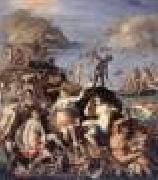 |
ZUCCHI, Jacopo
|
|
Italian Painter, ca.1540-1596. Jacopo Zucchi was an Italian painter of the Florentine school. Italian painter and draughtsman. He was trained in the studio of Vasari, whom he assisted in the decoration of the Palazzo Vecchio, Florence, as early as 1557. He accompanied Vasari to Pisa in 1561, from when dates his earliest known drawing, Aesculapius (London, BM). Between 1563 and 1565 he was again in Florence and is documented working with Vasari, Joannes Stradanus and Giovan Battista Naldini on the ceiling of the Sala Grande (Salone dei Cinquecento) in the Palazzo Vecchio; a drawing of an Allegory of Pistoia (Florence, Uffizi) is related to the ceiling allegories of Tuscan cities. In 1564 Zucchi entered the Accademia del Disegno and contributed to the decorations erected for the funeral of Michelangelo. He travelled to Rome with Vasari and was his chief assistant on decorations in the Vatican in 1567 and 1572,
|
|
 |
ZUCCHI Jacopo
|
|
Italian Painter, ca.1540-1596
Italian painter and draughtsman. He was trained in the studio of Vasari, whom he assisted in the decoration of the Palazzo Vecchio, Florence, as early as 1557. He accompanied Vasari to Pisa in 1561, from when dates his earliest known drawing, Aesculapius (London, BM). Between 1563 and 1565 he was again in Florence and is documented working with Vasari, Joannes Stradanus and Giovan Battista Naldini on the ceiling of the Sala Grande (Salone dei Cinquecento) in the Palazzo Vecchio; a drawing of an Allegory of Pistoia (Florence, Uffizi) is related to the ceiling allegories of Tuscan cities. In 1564 Zucchi entered the Accademia del Disegno and contributed to the decorations erected for the funeral of Michelangelo. He travelled to Rome with Vasari and was his chief assistant on decorations in the Vatican in 1567 and 1572,
|
|
 |
ZOFFANY Johann
|
|
German/English painter (b. 1733, Frankfurt, d. 1810, Strand-on-the-Green)
|
|
 |
ZIMMERMANN Johann Baptist
|
|
German painter, Bavarian school (b. 1680, Wessobrun, d. 1758, Menchen).
Painter and stuccoist. Much of his early stuccowork and frescoes, such as that in the choir of Gosseltshausen parish church (1701) and the refectories of the abbeys at Tegernsee, Weyarn and Beyharting (before 1710), has been destroyed. His earliest surviving stuccowork (1707-9) is in the pilgrimage church of Maria Schnee, near Markt Rettenbach, and reveals the influences of Johann Schmuzer from Wessobrunn and an Italian stucco workshop that practised in Tegernsee.
|
|
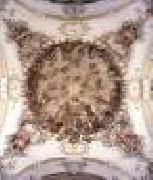 |
ZEILLER, Jakob Johann
|
|
German painter (b. 1708, Reutte, d. 1783, Reutte)
Austrian painter. Trained initially by his father, Paul Zeiller (1658-1738), he subsequently studied in Italy (1723-32) with Sebastiano Conca and at the Accademia di S Luca in Rome, and with Francesco Solimena in Naples, then at the Kaiserliche Akademie in Vienna. From 1733 to 1743 he was a regular collaborator on Paul Troger's frescoes, contributing mainly architectural frameworks painted in the style of the Bolognese quadraturisti. He retained such frameworks in his own paintings throughout his life, even in south Germany where this was generally unusual. Troger's influence on the style of Zeiller's figures and on his iconographic repertory was such that his first independent works in Austria
|
|
|
|
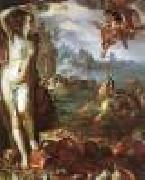 |
WTEWAEL, Joachim
|
|
Dutch painter (b. 1566, Utrecht, d. 1638, Utrecht).
Dutch painter and draughtsman. He was one of the last exponents of MANNERISM. From c. 1590 until 1628, the year of his latest known dated paintings, he employed such typical Mannerist formal devices as brilliant decorative colour, contrived spatial design and contorted poses. He sometimes combined such artifice with naturalism, and this amalgam represents the two approaches Dutch 16th- and 17th-century theorists discussed as uyt den geest ('from the imagination') and naer 't leven ('after life'). Wtewael's activity reflects the transition from Mannerism to a more naturalistic style in Dutch art. Slightly over 100 of his paintings and about 80 drawings are known. Subjects from the Bible and mythology predominate;
|
|
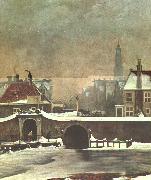 |
Wouter Johannes van Troostwijk
|
|
1782-1810
Dutch
Wouter Johannes van Troostwijk Gallery
Dutch painter, draughtsman and etcher. In 1803 he was admitted to the Amsterdam Tekenacademie where he was a pupil of the director, Jurriaan Andriessen. Despite a highly successful student career that culminated in a gold medal from the Felix Meritis Society in 1807, he was unable to establish himself as a professional artist during the remainder of his very short working life in Amsterdam. Andriessen's studies from nature seem to have been an important influence; van Troostwijk was one of the earliest artists to paint en plein air. Although he looked back to 17th-century Dutch landscape art and to the work of his contemporaries, in such paintings as Landscape in Gelderland (c. 1808; Amsterdam, Rijksmus.; see NETHERLANDS, THE, fig. 21) he achieved a totally new lyricism in the rendering of atmospheric effects. The Raampoortje (1809; Amsterdam, Rijksmus.) displays a fresh colouristic touch rare in Dutch painting of this period. His Self-portrait (c. 1810; Amsterdam, Rijksmus.) is equally original in composition and colour. He also produced animal paintings in the manner of Paulus Potter, drawings and a few etchings towards the end of his life. Van Troostwijk died before his considerable talents could be recognized, and, although he has come to be seen as an important precursor of much late 19th-century Dutch painting, he had little influence on his immediate successors.
|
|
|
|
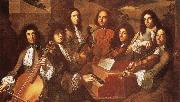 |
william wordsworth
|
|
Born: 7 April 1770
Birthplace: Cockermouth, England
Died: 23 April 1850
Best Known As: The author of the poem "Tintern Abbey"
|
|
|
|
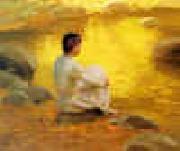 |
William Lees Judson
|
|
1842-1928
William Lees Judson was born in 1842 in Manchester, England, and moved to the United States with his parents when he was ten years old. After serving four years with the Illinois volunteers during the American Civil War, Judson studied art in New York and Paris. He settled in London, Ontario, where he became a successful portrait painter and art teacher. He moved to Chicago in 1890 but, suffering from failing health, he moved to Los Angeles in 1893. He settled on the banks of the Arroyo Seco in the Garvanza section of Los Angeles. A 1937 radio program noted that it was ??love at first sight?? when Judson saw the Arroyo Seco, and the area became his home for the rest of his life. Soon after his arrival, Judson was at the forefront of the Arroyo Guild of Craftsmen, an influential group of artists, sculptors and architects who fueled Southern California??s Arts and Crafts Movement. The beauty of the area stirred Judson to switch from portrait painting to landscapes, and his work attracted such favorable attention that in 1896 he was offered a professorship in drawing and painting at the University of Southern California. In the late 1890s, he founded the Los Angeles College of Fine Arts at his home in Garvanza (the present location of Judson Studios). In 1901, Judson's art college became USC??s College of Fine Arts, with Judson serving as dean from 1901 until his retirement in 1922. He died at his home in the studio building in October 1928.
|
|
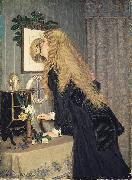 |
William John Hennessy
|
|
(July 11, 1839 - December 27, 1917) was an Irish artist.
William John Hennessy was born in Thomastown, County Kilkenny in 1839. His father, John Hennessy, was forced to leave Ireland in 1848 as a result of his involvement in the Young Ireland movement. He landed in Canada and settled in New York. William, his mother Catherine, and brother joined their father there in 1849. He gained admittance to the National Academy of Design in 1854 and exhibitioned his first works there.
Hennessy developed a skill in wood engraving and was hired to illustrate the works of renowned poets, including that of Tennyson, Longfellow and Whittier. As an American he became the co-founder of the Artists Fund Society, and an honorary member of the American Society of Painters in Watercolours. In 1870 he moved to London where he became a member of the Royal Institute of Oil Painters in 1902. Between 1879 and 1907 the Royal Hibernian Academy displayed eight of his paintings.
|
|
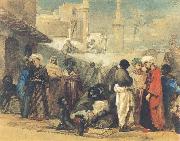 |
William James Muller
|
|
British Painter, 1812-1845, English landscape and figure painter, was born at Bristol, his father, a Prussian, being curator of the museum. He first studied painting under JB Pyne. His early subjects deal mainly with the scenery of Gloucestershire and Wales, and he learned much from his study of Claude, Ruysdael, and earlier landscape-painters. In 1833 he figured for the first time in the Royal Academy with his "Destruction of Old London Bridge--Morning," and next year he made a tour through France, Switzerland and Italy. Four years later he visited Athens, extending his travels to Egypt, and in the sketches executed during this period and the paintings produced from them his power and individuality are apparent. Shortly after his return he left Bristol and settled in London, where he exhibited regularly. In 1840 he again visited France, where he executed a series of sketches of Renaissance architecture, twenty-five of which were lithographed and published in 1841, in a folio entitled "The Age of Francis I. of France." In 1843 he accompanied,
|
|
|
|
 |
William Jacob Baer
|
|
William Jacob Baer (January 29, 1860 - 1941) considered the foremost American miniature painter was born in Cincinnati, Ohio January 29, 1860 and died in East Orange, New Jersey in 1941
|
|
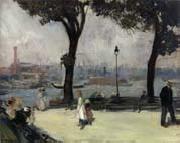 |
William J.Glackens
|
|
March 13.1870-May 22.1938,American painter and illustrator. He graduated in 1889 from Central High School, Philadelphia, where he had known Albert C. Barnes, who later became a noted collector of modern art. He became a reporter-illustrator for the Philadelphia Record in 1891 and later for the Philadelphia Press. In 1892 he began to attend evening classes in drawing at the Pennsylvania Academy of Fine Arts, studying under Thomas Anshutz. In the same year he became a friend and follower of Robert Henri, who persuaded him to take up oil painting in 1894.
|
|
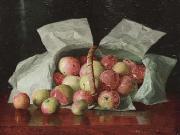 |
William J. McCloskey
|
|
painted Lady Apples in Overturned Basket. Signed W.J. McCloskey in 1941
United States (1859- 1941 ) - Painter
|
|
|
|
|
|
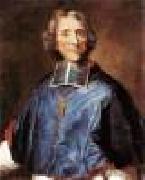 |
VIVIEN, Joseph
|
|
French painter (b. 1657, Lyon, d. 1734, Bonn)
French painter and pastellist, active in Germany. He trained in Paris in 1672 with the painter Fran?ois Bonnemers (1638-89), also attending the Acad?mie Royale, where his oil painting the Punishment of Adam and Eve (untraced) won a second prize in 1678. Only in 1698 was he received (re?u) at the Acad?mie, as a pastellist, on presentation of portraits of the sculptor Fran?ois Girardon and of the architect Robert de Cotte (both Paris, Louvre; see PASTEL, fig. 1). Having been commissioned to execute a pastel Self-portrait (Florence, Uffizi) by Maximilian II Emanuel, Elector of Bavaria, in 1699, the following year he was appointed the Elector's principal court painter (see WITTELSBACH). He henceforth divided his time between Paris, the Elector's courts at Brussels and Munich,
|
|
|
|
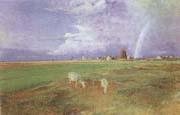 |
Viggo Johansen
|
|
Danish Realist Painter, 1851-1935
Danish painter. He trained at the Kongelige Akademi for de Skenne Kunster from 1868 to 1875 under Jergen Roed. In 1871 he began to visit the fishing hamlet of Hornbek on the north coast of Zealand, not far from Copenhagen, often with painters such as Peter Severin Kreyer and Kristian Zahrtmann. Here Johansen painted pure landscapes, or alternatively figures from the village traditional population, seen in their homes. A Meal (1877; Copenhagen, Hirschsprungske Saml.) shows an elderly fisherman seated at table eating potatoes, attended by his wife; dull daylight from a window in which a net is drying illumines the frugal interior and worn figures.
|
|
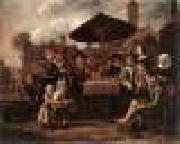 |
VICTORS, Jan
|
|
1619-1676 . Dutch painter.
He was half-brother to the bird painter Jacobus Victors (1640-1705) and the noted Delft potter Victor Victors (b 1638). About 150 oil paintings by Jan Victors, comprising portraits, genre scenes and historical subjects on both canvas and panel, have been catalogued. No signed or securely attributable drawing by him is known. Although his training is undocumented, Victors has long been considered a member of the school of Rembrandt in Amsterdam. His paintings of 1640-70 show many formal and thematic interrelationships with Rembrandt and his documented pupils of the 1630s
|
|
|
|
|
|
|
|
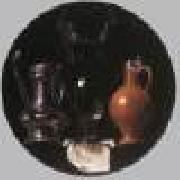 |
TORRENTIUS, Johannes
|
|
Dutch painter (b. 1589, Amsterdam, d. 1644, Amsterdam).
Dutch painter. He was active in Amsterdam, Leiden and Haarlem. In Haarlem in 1627 he was condemned, after severe torture, to 20 years of imprisonment for impiety, blasphemy and his membership of the outlawed Society of Rosicrucians. After having been notified by Sir Dudley Carleton, the British ambassador in The Hague, Charles I of England intervened and brought about Torrentius's release in 1629. Torrentius was subsequently active from 1629 to 1632 in London, which he nevertheless had to leave, again on account of his purportedly immoral mode of life; he returned to Amsterdam. There he was again involved in a trial and died after suffering torture in 1644. His erotic pictures, some of which depicted masterful nudes in mythological settings and are now known only through literary sources, were publicly burnt. A few still-lifes (e.g. Emblematic Still-life, 1614; Amsterdam, Rijksmus.) have survived. These carefully composed works, mostly set before a dark background, recall the work of Jan van de Velde II and the circle of Willem Claesz. Heda.
|
|
|
|
|
|
|
|
|
|
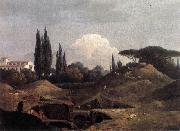 |
Thomas Jones
|
|
Thomas Jones (26 September 1742 - 29 April 1803) was a British landscape painter. He was a pupil of Richard Wilson and was best known in his lifetime as a painter of Welsh and Italian landscapes in the style of his master. However, Jones's reputation grew in the 20th century when more unconventional works by him, ones not been intended for public consumption, came to light. Most notable among these is a series of views of Naples which he painted from 1782 to 1783. By breaking with the conventions of classical landscape painting in favour of direct observation, they look forward to the work of Camille Corot and the Barbizon School in the 19th century. His autobiography, Memoirs of Thomas Jones of Penkerrig, went unpublished until 1951 but is now recognised as a major work of commentary on the 18th-century art world.
|
|
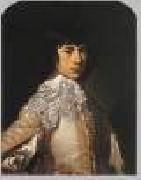 |
TASSEL, Jean
|
|
French Baroque Era Painter, ca.1608-1667
Son of Richard Tassel, with whose works his own were for a long time confused. He trained with his father and by 1634 was recorded in Rome, where he came into contact with his fellow Frenchmen Claude Lorrain, Nicolas Poussin and Sebastien Bourdon. Like the last he was influenced by the Bamboccianti, and he painted a number of low-life genre scenes at this period; these include Singers in a Tavern (Kassel, Schloss Wilhelmshehe) and Travellers Attacked (Warsaw, N. Mus.). He had returned to Langres by 1647, the date of his marriage, and continued to paint genre pictures after this, such as The Sawyers (Strasbourg, Mus. B.-A.) and The Marauders (Langres, Mus. St Didier). Other influences from Rome include Caravaggio, strong in a picture such as the Fortune-teller (sold Paris, Drouot, 1 April 1987, ) but far less apparent in the Presentation of the Infant Jesus (Dijon, Mus. B.-A.) and Tobias and the Angel (Dijon, Mus. B.-A.). However, the most lasting influence was that of the Romano-Bolognese school, seen in later pictures such as the Annunciation
|
|
|
|
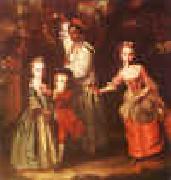 |
Sir Joshua Reynolds
|
|
British
1723-1792
Sir Joshua Reynolds Locations
Reynolds was born in Plympton, Devon, on 16 July 1723. As one of eleven children, and the son of the village school-master, Reynolds was restricted to a formal education provided by his father. He exhibited a natural curiosity and, as a boy, came under the influence of Zachariah Mudge, whose Platonistic philosophy stayed with him all his life.
Showing an early interest in art, Reynolds was apprenticed in 1740 to the fashionable portrait painter Thomas Hudson, with whom he remained until 1743. From 1749 to 1752, he spent over two years in Italy, where he studied the Old Masters and acquired a taste for the "Grand Style". Unfortunately, whilst in Rome, Reynolds suffered a severe cold which left him partially deaf and, as a result, he began to carry a small ear trumpet with which he is often pictured. From 1753 until the end of his life he lived in London, his talents gaining recognition soon after his arrival in France.
Reynolds worked long hours in his studio, rarely taking a holiday. He was both gregarious and keenly intellectual, with a great number of friends from London's intelligentsia, numbered amongst whom were Dr Samuel Johnson, Oliver Goldsmith, Edmund Burke, Giuseppe Baretti, Henry Thrale, David Garrick and fellow artist Angelica Kauffmann. Because of his popularity as a portrait painter, Reynolds enjoyed constant interaction with the wealthy and famous men and women of the day, and it was he who first brought together the famous figures of "The" Club.
With his rival Thomas Gainsborough, Reynolds was the dominant English portraitist of 'the Age of Johnson'. It is said that in his long life he painted as many as three thousand portraits. In 1789 he lost the sight of his left eye, which finally forced him into retirement. In 1791 James Boswell dedicated his Life of Samuel Johnson to Reynolds.
Reynolds died on 23 February 1792 in his house in Leicester Fields, London. He is buried in St. Paul's Cathedral.
|
|
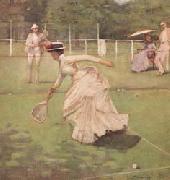 |
Sir John Lavery,RA
|
|
1856-1941
The artist John Lavery was born in Belfast, and studied in Scotland at the Glasgow School of Art from about 1874. He was in London from 1879-81 (he studied at Heatherley's School of Art for six months), and later in Paris, where he was influenced by Bastien-Lepage. He then returned to Glasgow, becoming a leading member of informal group of painters known as the Glasgow School (James Guthrie was another member), with work characterised by lack of a storyline, but great energy. Lavery achieved his pinnacle in the 1880s, with exhibitions in Europe and America, and as a leading portraitist, he was chosen to paint the State visit of Queen Victoria to the International Exhibition in Glasgow, 1888 - there were some 250 portraits in that picture. From 1890 he visited Morocco frequently, and he changed his British base to London in 1896, where he used a studio belonging to Alfred East. He was elected ARA in 1911,
|
|
 |
Sir John Lavery
|
|
Irish Painter, 1856-1941
Irish painter. The son of an unsuccessful publican, he was orphaned at the age of three and was brought up by relatives, initially in the north of Ireland and then in Ayrshire. He became an apprentice retoucher to a Glasgow photographer and attended the Haldane Academy, Glasgow, in the 1870s. After spending a winter term at Heatherley's School of Art, London, he moved in 1881 to Paris where he studied at the Acad?mie Julian. At this time he was influenced by Jules Bastien-Lepage and painted in a plein-air naturalist style
|
|
|
|
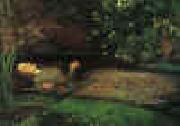 |
Sir John Everett Millais
|
|
British 1829-1896 Sir John Everett Millais Galleries After his marriage, Millais began to paint in a broader style, which was condemned by Ruskin as "a catastrophe". It has been argued that this change of style resulted from Millais' need to increase his output to support his growing family. Unsympathetic critics such as William Morris accused him of "selling out" to achieve popularity and wealth. His admirers, in contrast, pointed to the artist's connections with Whistler and Albert Moore, and influence on John Singer Sargent. Millais himself argued that as he grew more confident as an artist, he could paint with greater boldness. In his article "Thoughts on our art of Today" (1888) he recommended Vel??zquez and Rembrandt as models for artists to follow. The Two Princes Edward and Richard in the Tower (1878) The Boyhood of Raleigh (1871)Paintings such as The Eve of St. Agnes and The Somnambulist clearly show an ongoing dialogue between the artist and Whistler, whose work Millais strongly supported. Other paintings of the late 1850s and 1860s can be interpreted as anticipating aspects of the Aesthetic Movement. Many deploy broad blocks of harmoniously arranged colour and are symbolic rather than narratival. Later works, from the 1870s onwards demonstrate Millais' reverence for old masters such as Joshua Reynolds and Vel??zquez. Many of these paintings were of an historical theme and were further examples of Millais' talent. Notable among these are The Two Princes Edward and Richard in the Tower (1878) depicting the Princes in the Tower, The Northwest Passage (1874) and the Boyhood of Raleigh (1871). Such paintings indicate Millais' interest in subjects connected to Britain's history and expanding empire. His last project was to be a painting depicting a white hunter lying dead in the African veldt, his body contemplated by two indifferent Africans. This fascination with wild and bleak locations is also evident in his many landscape paintings of this period, which usually depict difficult or dangerous terrain. The first of these, Chill October (1870) was painted in Perth, near his wife's family home. Many others were painted elsewhere in Perthshire, near Dunkeld and Birnam, where Millais rented grand houses each autumn in order to hunt and fish. Millais also achieved great popularity with his paintings of children, notably Bubbles (1886) ?C famous, or perhaps notorious, for being used in the advertising of Pears soap ?C and Cherry Ripe.
|
|
|
|
 |
Sir Edward john poynter,bt.,P.R.A
|
|
1836-1919
English painter, draughtsman, decorative designer and museum official. He came from an artistic family: his great-grandfather was Thomas Banks the sculptor, and Ambrose Poynter, his father, was an architect and watercolour painter. Edward began studying art in 1852 under Thomas Shotter Boys, a friend of his father. In 1853-4 Poynter visited Rome, where he was greatly impressed by the large-scale academic painting of Frederic Leighton. Returning to London, he studied at Leigh's Academy and the studio of William Dobson (1817-1898). Poynter entered the Royal Academy Schools in 1855 but his admiration for French painting led him to Charles Gleyre's studio in Paris the following year. He remained there until 1859, with fellow students George Du Maurier, Thomas Armstrong and Whistler; their activities are described in Du Maurier's novel Trilby (1894). At this time Poynter received his first commissions for decorative work. He began designing stained glass and painting furniture and, after his return to England, he was employed by his friend the architect William Burges to decorate the ceiling of Waltham Abbey, Essex, in 1860.
|
|
|
|
|
|
 |
Sir Edward Coley Burne-Jones
|
|
British Pre-Raphaelite Painter, 1833-1898
English painter and decorative artist. He was the leading figure in the second phase of the Pre-Raphaelite movement. His paintings of subjects from medieval legend and Classical mythology and his designs for stained glass, tapestry and many other media played an important part in the Aesthetic Movement and the history of international Symbolism.
|
|
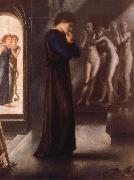 |
Sir Edward Burne-Jones
|
|
Britain 1833-1898
English painter and decorative artist. He was the leading figure in the second phase of the Pre-Raphaelite movement. His paintings of subjects from medieval legend and Classical mythology and his designs for stained glass, tapestry and many other media played an important part in the Aesthetic Movement and the history of international Symbolism.
|
|
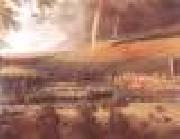 |
SIBERECHTS, Jan
|
|
Flemish Baroque Era Painter, 1627-1703
Flemish painter, active in England. He was the son of the sculptor of the same name and became a master in the Guild of St Luke in Antwerp by 1648. He married in 1652 and moved to England sometime between 1672 and 1674.
|
|
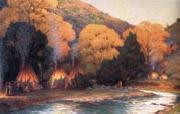 |
Sharp Joseph Henry
|
|
American Painter, 1859-1953
was a painter credited with influencing the creation of the Taos, New Mexico Society of Artists. Sharp may have been the first artist to discover Taos when he visited in 1883. He painted American Indian portraits and cultural life, and Western landscapes. As a youth he permanently damaged his hearing in a near-drowning accident, and gradually become totally deaf. His formal art training included Mckmicken School of Design (Cincinnati) and Antwerp (Belgium) Academy. He traveled and worked in Europe also. Harpers Magazine commissioned his illustrations of Taos Indian life. Some portraits were purchased by the Smithsonian Institution. President Theodore Roosevelt took an interest in him and had a cabin built for him at Little Big Horn to paint Indian life there.
|
|
|
|
|
|
|
|
|
|
|
|
|
| Wholesale China Oil Painting Wholesale Oil Painting China Xiamen Portrait Reproduction on canvas Chinese Oil Painting Wholesale USA Oil Painting |
|
|
|
|
|